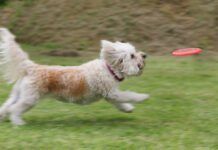When dogs fight, it can be scary and stressful for both owners and the dogs involved, especially if they result in injuries to the dogs or the people that attempt to break up the fight. Dogs can fight for different reasons and understanding those reasons—as well as body language precursors that can predict a fight—is important to help prevent fights. This helps keep dogs and the people they live with safe.
Why Do Dogs Fight?
Dog aggression is a common behavioral problem and is part of the normal canine behavioral repertoire. Although dog-to-dog aggression is commonplace, severe injuries and death are quite uncommon. Dogs fight for different reasons, the most common or which include:
- Resource guarding—typically food, toys, people, and/or space
- Fear or anxiety—often due to a lack of prior positive socialization and/or negative past experiences associated with other dogs
- Territorial behavior
- Social incompatibility
- Predatory aggression—where the victim dog (usually small and fluffy) triggers predatory behavior such as stalking, chasing, biting, and shaking
Dogs that fight other dogs in public can be labelled “dangerous dogs” and seized in many countries while the authorities investigate and decide their fate. Depending on the severity of the incident, this could include euthanasia and frequently involves confinement in kennels, often for long periods of time, significantly reducing welfare.
Warning Signs That Could Signal a Dog Fight

Although they can be subtle, most dogs will display warning signs that signal a fight may be imminent. These include stiff body posture, raised hackles, direct eye contact or a hard stare, freezing or sudden stillness, growling or barring teeth, and escalating arousal during play. Upon observing these signs, it is crucial to intervene in order to prevent a dog fight.
Dogs have different play styles and some enjoy the rough and tumble of a good play fight. Play fighting is a normal form of social interaction in which dogs display mock aggression without the intent to cause harm to one another. Indeed, puppies wrestle and play fight with their littermates almost continuously from the age of several weeks until they go to their new homes.
In older puppies and adult dogs this behavior can look very similar to a real dog fight, as it can include growling, biting, and wrestling. However, the intensity is moderated to prevent injuries.
One of the telltale signs that fighting is play is the “play bow” where a dog lowers the front end of her body so the front legs are flat on the ground and her back end is raised in the air. Another sign of a play “fight” is that the dogs will take turns when it comes to play fighting behaviors.
How to Prevent Dog Fights
Dogs that fight with other dogs and cause injury are a risk to public health and can cause physical and psychological damage to the victim. Prevention is therefore key to stopping dogs from fighting.
When possible, preventing dog fights starts with providing a dog with early and ongoing positive socialization experiences with a range of other dogs. This helps dogs learn how to interact appropriately with lots of different types of dogs. Remember that close supervision during interactions between dogs is important in order to ensure both are having a positive experience and interacting appropriately.
Additional prevention strategies include provision of adequate resources to minimize or prevent competition and avoiding situations which could result in dog fights—such as fear in response to certain types of dogs due to a lack of prior socialization or negative past experiences. You can also build positive associations between dogs by pairing them with high value treats and reinforcing calm, friendly, and compliant behavior in the presence of other dogs.
In addition, neutering and spaying can help reduce hormonal influences that may contribute to aggression.
Keep in mind that you can’t prevent dog fights you can’t see happening. Manage your dogs’ environment as necessary to avoid dogs escaping the property.
How to Break Up a Dog Fight
If you come upon a dog fight and need to break it up, this should be done very carefully in order to avoid being injured in the process. Never pull dogs apart by their collars or get in between fighting dogs as this often results in redirected aggression and bite injuries to the person. Instead, there are safer methods that should be used to break up a dog fight. These include:
- Distracting the fighting dogs with a loud noise (e.g. yelling, clapping, airhorn etc.), spraying them with a hose, or throwing a bucket of water over them can interrupt the fight and allow some time to separate the dogs.
- Using a physical barrier such as a flattened cardboard box, piece of plywood, or blanket placed between the dogs so they cannot see each other can help stop a dog fight.
- Pulling the dogs apart by grabbing their back legs and walking backwards helps create distance while minimizing the chance of a bite injury to the person.
- A bite stick (also called a break stick) is a tool used to help break a dog’s grip during a bite. These tools are especially helpful in bite incidents in which a dog will not let go as it’s designed to be inserted into the mouth and turned to pry open the jaw and release the bite.
What to Do After a Dog Fight
After the initial fight, dogs will often continue to fight, given the chance. To prevent further fights, it’s important to take the following steps:
First, physically separate the dogs to prevent them from seeing or interacting with one another.
Second, take the dogs to the vet for a thorough check. In addition to treating any injuries sustained during the fight, the vet will be able to help either identify or rule out health or medical issues that may have caused a dog to act aggressively. Cognitive decline, reduced eyesight and hearing, pain and arthritis are common contributing factors, especially when a dog hasn’t previously behaved aggressively.
Next, seek professional help from a qualified veterinary behaviorist or applied animal behaviorist who has relevant experience, especially if the fight has resulted in injuries.
Finally, re-introduce the dogs gradually using desensitization and counter-conditioning techniques to build a positive association and help repair their relationship. Separate the dogs outside of training sessions and when you cannot actively supervise them. This is best done with the help of a professional.
Long Term Management to Stop Dogs from Fighting in the Same Household
To help stop dogs in the same home from fighting in the long-term, good management and training practices are essential for success. Strategies to help prevent further fights should include:
- Continuing to physically separate the dogs, so they cannot see one another outside of training sessions and when you are able to actively supervise them
- Daily desensitization and counter-conditioning sessions to help rebuild and maintain a positive association between the dogs. These sessions can also be used to reinforce calm, compliant, and friendly (or at least tolerate) behavior toward one another. As mentioned above, this is best done with guidance from a professional.
- Avoid triggers for aggression, such as resource guarding, by feeding the dogs separately and giving them one-on-one attention when the other dog is in another room so they don’t compete for attention.
- Don’t leave high value items lying around such as bones, favorite toys, treats, or food in bowls.
- Muzzles are an excellent tool as the re-introduction process progresses to having the dogs spend time together in the same space whilst helping to avoid injuries. Be sure to condition the dogs to accept wearing the muzzles.
- Ensure regular check-ups with the vet to identify and treat health and medical issues that can contribute to aggression between dogs in the same home.
- Consistency in training and management are critical, as is having patience. It can take time to repair the relationship between dogs who have fought.
When to Seek Professional Help
Dog fights can be dangerous. If your dog’s aggression is frequent, escalates, or causes injuries it’s time to seek professional help from a qualified veterinary behaviorist or applied animal behaviorist.
References
Casey, R. A., Loftus, B., Bolster, C., Richards, G. J., & Blackwell, E. J. (2013). Inter‐dog aggression in a UK owner survey: prevalence, co‐occurrence in different contexts and risk factors. Veterinary Record, 172(5), 127-127.
Montrose, V. T., Squibb, K., Hazel, S., Kogan, L. R., & Oxley, J. A. (2020). Dog bites dog: The use of news media articles to investigate dog-on-dog aggression. Journal of Veterinary Behavior, 40, 7-15.
Notari, L., Cannas, S., Di Sotto, Y. A., & Palestrini, C. (2020). A retrospective analysis of dog–dog and dog–human cases of aggression in northern Italy. Animals, 10(9), 1662.






